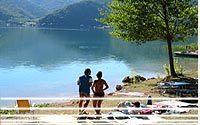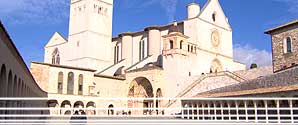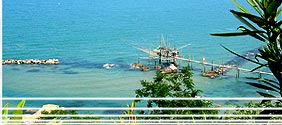 |
|
 |
City
of Assisi - Italy
 |
| |
-Basilica di Santa Maria degli Angeli (The Cathedral of St Maria degli Angeli)
The Cathedral of St Maria degli Angeli is very big ( it is the seventh biggest Christian church). They started to build it in 1596 and they finished it in 1679.
When you enter the cathedral, notice the Cappella di Transito (the Death Chapel), that was used as an infirmary when the Fransiscan friars put their seat there for the first time. It is also the place where St Francesco died on 4 October 1226. On the altar you can see a XV-century earthenware statue portraying St Francesco.
The crypt was built in order to give emphasis to the Franciscan constructions. The Tabernacle is made of enamel earthenware and it shows events such as: the birth of Jesus, the Three Kings' visit, the Madonna's crowning and St Francesco getting the stigmata. |
|
 |
| |
-Basilica di San Francesco (The Cathedral of St Francesco)
St Francesco died in 1226. Two years later, in 1228, they started to build the Basilica di San Francesco. Over two years the lower section of the cathedral was finished thanks to Friar Elia's strong determination and to Assisi inhabitants' help. Since 1230 St Francesco's mortal remains have been kept just in the lower section of the cathedral. On the walls and on the vaults you can see beautiful paintings by Giotto, Martini and Lorenzetti, portraying Christ's life and St Francesco's life.
The upper section of the cathedral, in Gothic-style, is well-known all over the world for the frescoes by Cimabue and by Giotto. There you can see big windows on the walls along the nave, the choir and the transept. The Romantic-style belfry was made in 1239.
Since a long time they are the most venerated Christian Sanctuaries.
|
|
 |
|
-Rocca Maggiore (The Main Castle)
The early news about the fortress date back to 1174. It was built as a German feudal castle. Frederick from Swabia, the future King Frederick II, spent there some years of his childhood. Because of some independence rebellions the castle was destroyed by Assisi's inhabitants. Only in 1367 Cardinal Albornoz made it built again by using the outer western embattled walls and some pieces belonging to the inside walls.
After that the dodecagonal Tower was restored too. Since the castle was no longer a defensive place, it was abandoned.
Recently it has been restored, so that many rooms are still like they were in the past. Today the castle is often the seat of art exhibitions.
|
|
 |
|
-Eremo delle Carceri (Carceri Hermitage)
The Carceri Hermitage lies on Mount Subasio. Before St Francesco's birth, some friars founded several hermitages that were afterwards abandoned.
St Francesco was soon attracted by the Carceri Hermitage so that he and the Franciscan friars used to stay there whenever they looked for solitude.
The Convent is made up of some overlapping buildings lying in the middle of the Carceri ditch. When you enter, you see a courtyard with two wells. Inside the cloister you get to the small Church of St Bernardino.
In the Cave St Francesco used to sleep. Near the cave you can visit the Oratory: on the altar you can admire a XV-century fresco portraying St Francesco praying opposite the Crucifix.
|
|
|
|
|
 |
 |
| Beach
hotels |
| the most beautiful beaches
of Italy in the best hotels |
|
|
|


